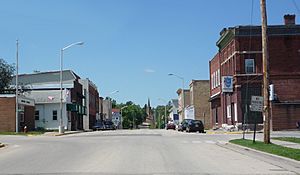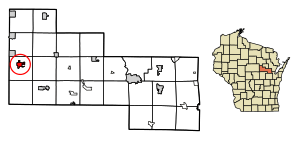Wittenberg, Wisconsin facts for kids
Quick facts for kids
Wittenberg, Wisconsin
|
|
|---|---|

Wittenberg
|
|

Location of Wittenberg in Shawano County, Wisconsin.
|
|
| Country | |
| State | |
| County | Shawano |
| Area | |
| • Total | 1.81 sq mi (4.69 km2) |
| • Land | 1.81 sq mi (4.69 km2) |
| • Water | 0.00 sq mi (0.00 km2) |
| Elevation | 873 ft (266 m) |
| Population
(2010)
|
|
| • Total | 1,081 |
| • Estimate
(2019)
|
988 |
| • Density | 545.25/sq mi (210.54/km2) |
| Time zone | UTC-6 (Central (CST)) |
| • Summer (DST) | UTC-5 (CDT) |
| ZIP code |
54499-9033
|
| Area code(s) | 715 & 534 |
| FIPS code | 55-88350 |
| GNIS feature ID | 1576924 |
| Website | http://www.villageofwittenberg.com |
Wittenberg is a small village located in Shawano County, Wisconsin, in the United States. In 2010, about 1,081 people lived there. The village is part of the larger Town of Wittenberg.
Contents
History of Wittenberg Village
The Wittenberg Indian School
In 1886, a special school called the Wittenberg Indian School was started. It was built by the Norwegian Evangelical Church of America. They bought land in what was traditionally Winnebago territory.
This school was a boarding school for Native American children. The government often took these children from their families. This was part of an effort to make Native Americans live like white American culture. The school was also known as the Bethany Indian Mission.
Challenges and Growth of the School
At first, it was hard to get students for the school. Some Winnebago "medicine men" were worried. They thought the missionaries wanted to change the children's religion to Christianity.
The school started with only a few children. But over time, it grew to have more than a hundred students. These students came from many different Native American nations. They included the Winnebago, Oneida, Stockbridge, Brothertown, Menominee, Mohawk, and Chippewa.
School Changes and Closure
In 1900, the school was sold to the government. It continued to operate until 1917. It closed because of World War I. Even after the government school closed, the mission kept teaching Native children. They taught up to 140 students with only four staff members. They also baptized many local Native people. Having many students and few staff was common in these schools. This was noted in the Merriam Report.
Naming the Village
A post office opened in Wittenberg in 1880. The village was named after Wittenberg in Germany.
Geography of Wittenberg
Wittenberg is located at 44°49′25″N 89°10′2″W / 44.82361°N 89.16722°W. This helps us find it on a map.
The village covers an area of about 1.79 square miles (4.64 square kilometers). All of this area is land.
Population and People
| Historical population | |||
|---|---|---|---|
| Census | Pop. | %± | |
| 1890 | 726 | — | |
| 1900 | 798 | 9.9% | |
| 1910 | 1,090 | 36.6% | |
| 1920 | 854 | −21.7% | |
| 1930 | 863 | 1.1% | |
| 1940 | 900 | 4.3% | |
| 1950 | 874 | −2.9% | |
| 1960 | 892 | 2.1% | |
| 1970 | 895 | 0.3% | |
| 1980 | 997 | 11.4% | |
| 1990 | 1,145 | 14.8% | |
| 2000 | 1,177 | 2.8% | |
| 2010 | 1,081 | −8.2% | |
| 2019 (est.) | 988 | −8.6% | |
| U.S. Decennial Census | |||
Population in 2010
In 2010, a census counted 1,081 people living in Wittenberg. There were 427 households and 231 families. The village had about 604 people per square mile (233 people per square kilometer).
Most people in the village were White (89.3%). About 3.8% were Native American. Some people were from other races (5.1%) or from two or more races (1.7%). About 7.1% of the population was Hispanic or Latino.
Households and Families
About 29% of households had children under 18 living there. Many households (35.6%) were married couples. Some households (40.5%) had just one person living alone. About 18.5% of these single-person households were people aged 65 or older.
The average household had 2.19 people. The average family had 2.94 people.
Age of Residents
The average age in the village was 42.2 years.
- 22.7% of residents were under 18 years old.
- 8% were between 18 and 24 years old.
- 22.6% were between 25 and 44 years old.
- 21% were between 45 and 64 years old.
- 25.6% were 65 years or older.
More females (53.4%) lived in the village than males (46.6%).
Economy
One well-known business in Wittenberg is Nueske's Applewood Smoked Meats. They are famous for their smoked meats.
Notable People from Wittenberg
- John Englund: He was a Wisconsin State Senator and worked as a newspaper editor.
- Helmer Swenholt: He was an officer in the United States Army. He was born in Wittenberg.
- Jonas Swenholt: He was a Wisconsin State Representative and a businessman. He lived in Wittenberg.
See also
 In Spanish: Wittenberg (Wisconsin) para niños
In Spanish: Wittenberg (Wisconsin) para niños


